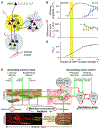Theory of hierarchically organized neuronal oscillator dynamics that mediate rodent rhythmic whisking
- PMID: 36113472
- PMCID: PMC10248719
- DOI: 10.1016/j.neuron.2022.08.020
Theory of hierarchically organized neuronal oscillator dynamics that mediate rodent rhythmic whisking
Abstract
Rodents explore their environment through coordinated orofacial motor actions, including whisking. Whisking can free-run via an oscillator of inhibitory neurons in the medulla and can be paced by breathing. Yet, the mechanics of the whisking oscillator and its interaction with breathing remain to be understood. We formulate and solve a hierarchical model of the whisking circuit. The first whisk within a breathing cycle is generated by inhalation, which resets a vibrissa oscillator circuit, while subsequent whisks are derived from the oscillator circuit. Our model posits, consistent with experiment, that there are two subpopulations of oscillator neurons. Stronger connections between the subpopulations support rhythmicity, while connections within each subpopulation induce variable spike timing that enhances the dynamic range of rhythm generation. Calculated cycle-to-cycle changes in whisking are consistent with experiment. Our model provides a computational framework to support longstanding observations of concurrent autonomous and driven rhythmic motor actions that comprise behaviors.
Keywords: brainstem; breathing; medulla; network; oscillations; rate modeling; synchrony; vibrissa.
Copyright © 2022 Elsevier Inc. All rights reserved.
Conflict of interest statement
Declaration of interests The authors declare no competing interests.
Figures








Similar articles
-
The whisking oscillator circuit.Nature. 2022 Sep;609(7927):560-568. doi: 10.1038/s41586-022-05144-8. Epub 2022 Aug 31. Nature. 2022. PMID: 36045290 Free PMC article.
-
The Brainstem Oscillator for Whisking and the Case for Breathing as the Master Clock for Orofacial Motor Actions.Cold Spring Harb Symp Quant Biol. 2014;79:29-39. doi: 10.1101/sqb.2014.79.024794. Epub 2015 Apr 15. Cold Spring Harb Symp Quant Biol. 2014. PMID: 25876629 Free PMC article.
-
Inhibition, Not Excitation, Drives Rhythmic Whisking.Neuron. 2016 Apr 20;90(2):374-87. doi: 10.1016/j.neuron.2016.03.007. Epub 2016 Mar 31. Neuron. 2016. PMID: 27041498 Free PMC article.
-
Anatomical loops and their electrical dynamics in relation to whisking by rat.Somatosens Mot Res. 1999;16(2):69-88. doi: 10.1080/08990229970528. Somatosens Mot Res. 1999. PMID: 10449057 Review.
-
Circuits in the rodent brainstem that control whisking in concert with other orofacial motor actions.Neuroscience. 2018 Jan 1;368:152-170. doi: 10.1016/j.neuroscience.2017.08.034. Epub 2017 Aug 23. Neuroscience. 2018. PMID: 28843993 Free PMC article. Review.
Cited by
-
Selective transduction and photoinhibition of pre-Bötzinger complex neurons that project to the facial nucleus in rats affects nasofacial activity.Elife. 2023 Sep 29;12:e85398. doi: 10.7554/eLife.85398. Elife. 2023. PMID: 37772793 Free PMC article.
-
A change in behavioral state switches the pattern of motor output that underlies rhythmic head and orofacial movements.Curr Biol. 2023 May 22;33(10):1951-1966.e6. doi: 10.1016/j.cub.2023.04.008. Epub 2023 Apr 26. Curr Biol. 2023. PMID: 37105167 Free PMC article.
-
The spinal premotor network driving scratching flexor and extensor alternation.Cell Rep. 2025 Jun 24;44(6):115845. doi: 10.1016/j.celrep.2025.115845. Epub 2025 Jun 17. Cell Rep. 2025. PMID: 40531617 Free PMC article.
-
A toolbox for ablating excitatory and inhibitory synapses.bioRxiv [Preprint]. 2025 Jan 31:2024.09.23.614589. doi: 10.1101/2024.09.23.614589. bioRxiv. 2025. Update in: Elife. 2025 Apr 29;13:RP103757. doi: 10.7554/eLife.103757. PMID: 39974889 Free PMC article. Updated. Preprint.
-
A toolbox for ablating excitatory and inhibitory synapses.Elife. 2025 Apr 29;13:RP103757. doi: 10.7554/eLife.103757. Elife. 2025. PMID: 40298577 Free PMC article.
References
-
- Ádám A, Kling U, 1971. On the behaviour of some cyclically symmetric networks. Acta Cybernetica 1, 69–79.
-
- Amit DJ, 1989. Modeling Brain Function: The World of Attractor Neural Networks. Cambridge University Press, Cambridge.
-
- Argaman T, Golomb D, 2018. Does layer 4 in the barrel cortex function as a balanced circuit when responding to whisker movements? Neuroscience 368, 29–45. URL: http://www.ncbi.nlm.nih.gov/pubmed/28774782, doi:10.1016/j.neuroscience.2017.07.054. - DOI - PubMed
-
- Ausborn J, Snyder AC, Shevtsova NA, Rybak IA, Rubin JE, 2018. State-dependent rhythmogenesis and frequency control in a half-center locomotor cpg. J Neurophysiol 119, 96–117. URL: http://www.ncbi.nlm.nih.gov/pubmed/28978767, doi:10.1152/jn.00550.2017. - DOI - PMC - PubMed
Publication types
MeSH terms
Grants and funding
LinkOut - more resources
Full Text Sources

